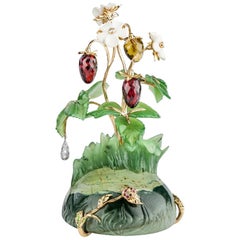Gold More Objets d'Art and Vertu
to
16
182
163
109
69
66
60
23
20
16
12
12
50
82
38
10
2
2
5
8
5
2
4
7
10
140
31
11
31
12
12
9
7
to
13
6
6
4
4
19
15
13
13
11
6
5
5
2
2
1
1
1
176
6
88
85
Metal: Gold
Diamond Bespoke 18 Kt White Gold Rectangular Engraved Modern Hasbani Cufflinks
Located in London, GB
We believe in creating your own unique look by creating your own style. These cufflinks are completely bespoke and exquisite for the discerning gentleman. Expertly hand crafted in s...
Category
2010s British Modern Gold More Objets d'Art and Vertu
Materials
Amethyst, Diamond, White Diamond, Yellow Diamond, Black Diamond, Emerald...
18 Karat Gold Flower Miniature Precious Berries by MOISEIKIN
By MOISEIKIN
Located in Hong Kong, HK
Gold floral compositions with precious or semi-precious stones or enamel became popular at the turn of the 20th century in Europe and Russia. Especially Imperial families and nobilities collected or gifted to important people.
The flowers are carved from cacholong —Russian milky opals — look so tender and natural.
Berries are skillfully cut from citrine and garnets. Golden stems are carved lively and embedded with rare Ural demantoid garnets. Fresh nephrite leaves are carved by hands. The intricate dewdrop is intricate.. embedded with diamonds.
On a green jasper ground, a lucky ladybug made of gold, rubies and black diamonds is enjoying the moment.
Perfectly expressed in the precious metal and stones by skillful craftsmen of MOISEIKIN®, the pleasant memory will not fade away.
This flower miniature is one of Precious Berry Collections and another piece is possessed by a known royalty who collects flower...
Category
21st Century and Contemporary Russian Contemporary Gold More Objets d'Art and Vertu
Materials
Citrine, Diamond, Garnet, Jade, 18k Gold
Price Upon Request
Recently Viewed
View AllMore Ways To Browse
Jomaz Mazer
Kieselstein Alligator
Kieselstein Cord 18k Bracelet
Kieselstein Cord Alligator
Koala Jewelry
Krementz Pin
Lapponia Pearl
Laura Gibson
Louis Comfort Tiffany Brooch
Mauboussin Mother Of Pearl
Micromosaic Parure
Mikimoto Rose Gold
Needle Baguette Diamond
Ruby Cherub
Ruby Tie Pins
Ruser Brooch
Sapphire Panther Brooch
Sapphire Riviere

